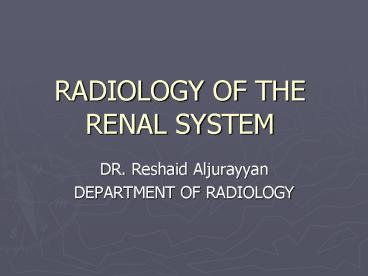RADIOLOGY OF THE RENAL SYSTEM - PowerPoint PPT Presentation
1 / 46
Title:
RADIOLOGY OF THE RENAL SYSTEM
Description:
RADIOLOGY OF THE RENAL SYSTEM DR. Reshaid Aljurayyan DEPARTMENT OF RADIOLOGY Renal stones Case two: Middle age women complaining of flank pain , fever and high WBC. – PowerPoint PPT presentation
Number of Views:323
Avg rating:3.0/5.0
Title: RADIOLOGY OF THE RENAL SYSTEM
1
RADIOLOGY OF THE RENAL SYSTEM
- DR. Reshaid Aljurayyan
- DEPARTMENT OF RADIOLOGY
2
Outline
- Introduction
- Imaging modalities used to study the renal system
- Anatomy and normal appearance of the renal system
- Common pathological cases
3
Introduction
- What is the radiology?
- Radiology is a medical specialty that employs the
use of imaging to both diagnose and treat disease
visualized within the human body. - What is the renal system?
4
Outline
- Introduction.
- Imaging modalities used to study the renal
system. - Anatomy and normal appearance of the renal
system. - Common pathological cases.
5
What are the radiological modalities that can be
used to image the renal system ?
6
Imaging modalities
- Conventional X-Ray
- IVU (intra-venous urogram) / X-Ray Contrast
- US
- CT
- MRI
- Nuclear medicine
7
Imaging modalities
- Conventional X-Ray
- IVU (intra-venous urogram) / X-Ray Contrast
- US
- CT
- MRI
- Nuclear medicine
- ALL CAN BE USED
8
Conventional Radiography (X-ray)
- ve
- Cheap widely available
- Often used as first choice
- -ve
- Radiation
- Limited anatomy
- Used for
- Evaluate abdomen pain
- Some time good for diagnosing kidney stones
9
- Radio lucent ? black (air)
- Radio opaque ? white (bone/stone)
10
Radiograph (X-ray)
Where are the kidneys ??
11
Radiograph (X-ray)
Where are the kidneys ??
12
IVU
- Same as X ray but with IV contrast
13
IVU
- ve
- Cheap available
- -ve
- Radiation
- Needs IV contrast (?reaction)
- Old (replaced by CT MRI)
- Used for
- To diagnose kidney stones
- To diagnose hydronephrosis
14
(No Transcript)
15
US
- Ultrasound.
- Use high frequency sound wave.
- Contrast between tissue is determined by sound
reflection.
16
US
- ve
- Available
- No radiation
- Good anatomy
- - ve
- Operator dependent
- Used for
- Good for kidney stones
- Excellent for hydronephrosis
- Excellent for focal lesion e.g. cysts, masses
17
- Hyper-echoic ? white
- Hypo-echoic ? grey
- An-echoic? black (fluid)
18
(No Transcript)
19
CT
- ve
- Relatively available (more then MRI)
- Very good anatomy
- - ve
- Radiation
- Some times need IV contrast (? reaction)
- Used for
- Excellent for kidney stones (the best)
- Excellent for hydronephrosis masses
- Excellent for kidney trauma
20
- Hyper-dense? white (stone/bone)
- Hypo-dense grey to black (fat/fluid)
21
(No Transcript)
22
(No Transcript)
23
CT
24
MRI
- ve
- Excellent anatomy details
- No radiation
- - ve
- Expensive
- Long scanning time (30 to 60 min)
- Not used to diagnosed kidney stone
- Used for
- Excellent for masses
- Good for hydronephrosis
25
- Hyper-intense (white)
- Hypo-intense (grey to black)
26
MRI
27
MRI
28
Nuclear medicine
- ve
- Excellent to assess function
- - ve
- Radiation
- Poor anatomy details
- Used for
- Evaluated function
- Evaluated obstruction
29
Nuclear medicine
- Image features
- Projectional image.
- Image contrast by tissue uptake and metabolism.
30
NM
31
Objectives
- Introduction.
- Imaging modalities used to study the back.
- Anatomy and normal appearance of the back.
- Common pathological cases.
32
Case one
- Young male patient presented with left flank pain
and hematuria no fever and normal WBC count.
33
Renal stones
34
Renal stones
35
Case two
- Middle age women complaining of flank pain ,
fever and high WBC.
36
Inflammatory/ infectious
37
Case three
- Old male patient complaining of recurrent renal
infection.
38
Hydronephrosis
39
Hydronephrosis
40
Case four
- Young female presented with decrease renal
function (high urea and creatinine level).
41
Congenital
42
Case six
- old male patient presented with pain less
hematura and weight loss.
43
Tumor
44
Case seven
- Young male patient involved in road traffic
accident with blunt trauma to the abdomen.
45
Trauma
46
THANK YOU































